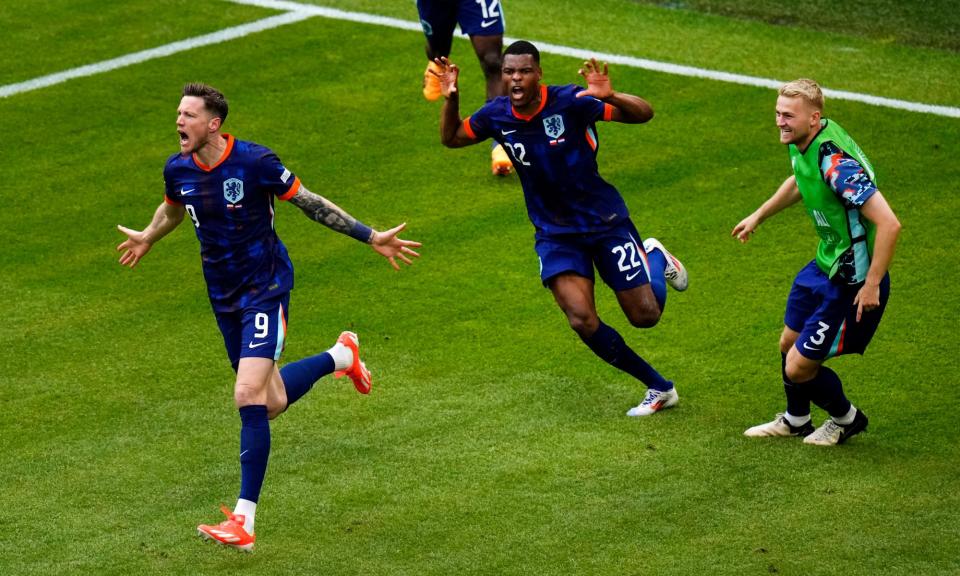Wout Weghorst rescues Netherlands after Poland give them a shock

There was the unforgettable star turn off the bench in the World Cup quarter-finals against Argentina in the artificial surrounds of Lusail, and now Wout Weghorst can stash away another compelling piece of evidence of his nose for goal in a Netherlands shirt at a major tournament.
In Qatar, Weghorst scored his first goal within five minutes of coming off the bench; the second goal, straight off the training ground from a Teun Koopmeiners free-kick, came in the 11th minute of stoppage time to force extra time. But he got to work more quickly here, the hulking striker sweeping in a priceless winner a couple of minutes after replacing the wasteful Memphis Depay. Cue the glorious L-shaped hue of oranje wrapped around a corner of this bowl singing his name at the final whistle.
Related: Christian Eriksen shines and scores but Denmark held late on by Slovenia
After Weghorst, 32 in August, preyed on a bouncing ball in the box with 83 minutes on the clock, swiping Nathan Aké’s deflected pass past Wojciech Szczesny, the Netherlands substitutes warming up on the touchline poured on to the pitch. Weghorst jumped into the arms of Stefan de Vrij, who partnered Virgil van Dijk in the centre of defence, and every outfield player joined the celebration. For all the concern and conjecture about the Frenkie de Jong‑shaped hole in midfield, it was the absence of a killer finisher that threatened to prevent them from winning their Group D opener against Poland. Until Weghorst, a boisterous No 9, stepped off the bench.
Not that he was overly happy to have been there in the first place. Afterwards Ronald Koeman told how he explained to the striker, who is contracted to Burnley but has spent the past two seasons on loan, at Besiktas, Manchester United and Hoffenheim, in that order, that he would likely feature as a substitute, with Depay a more dynamic starter in a team full of zest.
Still, there was a veiled compliment in Koeman’s message. “He was a little bit upset, but that’s a good reaction because you can be upset and not work hard,” the Netherlands head coach said. “Wout was upset but doing a lot of work to get the opportunity to start. That is a great mentality but it is always the last decision of the coach.”
“And coach: Ronald Koeman!” boomed the stadium announcer at the end of the Netherlands team news an hour before kick-off. Of course, he needs little introduction in these parts. It was at this stadium where the Netherlands recorded one of their sweetest victories, Koeman scoring a penalty in their semi-final victory over West Germany en route to winning the last European Championship in Germany, in 1988. He left a more indelible mark afterwards when, having swapped shirts with Olaf Thon, he celebrated topless in front of the locals by pretending to wipe his backside with Thon’s white jersey. Koeman’s older brother and long-time trusted assistant, Erwin, played on the left wing that day. Dutch supporters burned German flags on the terraces.
Here Koeman was in a royal blue polo shirt, considerably upstaged in the tailoring stakes by his opposite number, Michal Probierz, who in a beige three-piece suit looked primed to deliver a father‑of‑the‑bride speech. The Poland manager’s half‑time message would surely have been pretty chipper, given they shocked a dominant Netherlands side when Adam Buksa darted towards the front post to slide between Denzel Dumfries and Van Dijk and glance a header past the Brighton goalkeeper Bart Verbruggen and into the bottom corner.
Last week Probierz acknowledged his team, who qualified after an unconvincing playoff penalty shootout victory against Wales in March, had been roundly written off as whipping boys of Group D. That may yet prove accurate.
Download the Guardian app from the iOS App Store on iPhone or the Google Play store on Android by searching for 'The Guardian'.
If you already have the Guardian app, make sure you’re on the most recent version.
In the Guardian app, tap the Menu button at the bottom right, then go to Settings (the gear icon), then Notifications.
Turn on sport notifications.
Given the volume of chances, it was no surprise when the Netherlands levelled approaching the half-hour but Cody Gakpo’s equaliser was hardly Total Football. Gakpo drove towards Poland’s D and three players, sensing the danger, contorted their bodies to block the imminent shot, but Gakpo’s effort pinballed off one defender and skidded off Bartosz Salamon, wrong-footing a helpless Szczesny, who had dived to his right. The Netherlands finished with 21 shots, only four on target. “We should have scored before we did,” Koeman said. “It should have been 4-1 in our favour after an hour.”
The winner was not vintage either. Just as the Netherlands had gone a little stale, Koeman sent on Jeremie Frimpong and Weghorst in search of a goal. The former almost immediately snuck on to a through-ball only for Szczesny to smother but then Weghorst pounced inside the box after the ball bounced invitingly. “I already let my girlfriend know this morning: ‘I’m going to score at 0-0 or 1-1, just before the end,’” he said. “I said: ‘You have to come because it’s going to happen.’ Sometimes you feel it.”

